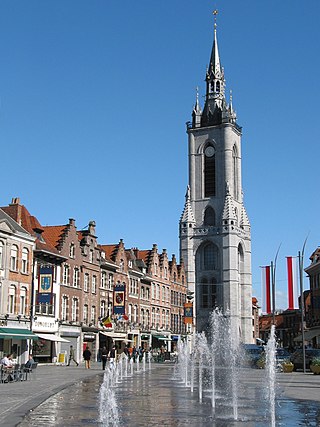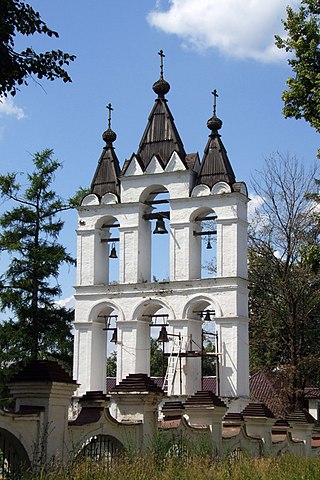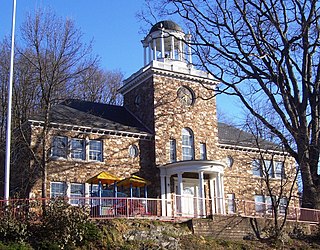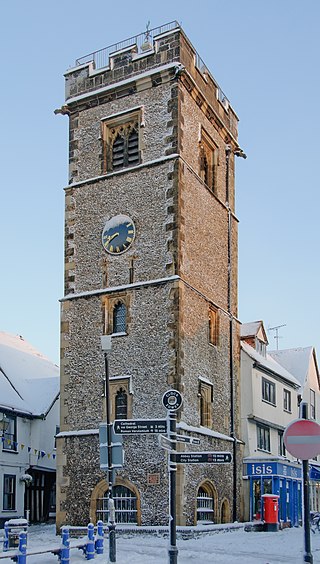Belfry may refer to:
Belfry may refer to:

Douai is a city in the Nord département in northern France. It is a sub-prefecture of the department. Located on the river Scarpe some 40 kilometres from Lille and 25 km (16 mi) from Arras, Douai is home to one of the region's most impressive belfries.

The belfry is a structure enclosing bells for ringing as part of a building, usually as part of a bell tower or steeple. It can also refer to the entire tower or building, particularly in continental Europe for such a tower attached to a city hall or other civic building.

A bell tower is a tower that contains one or more bells, or that is designed to hold bells even if it has none. Such a tower commonly serves as part of a Christian church, and will contain church bells, but there are also many secular bell towers, often part of a municipal building, an educational establishment, or a tower built specifically to house a carillon. Church bell towers often incorporate clocks, and secular towers usually do, as a public service.

In architecture, a steeple is a tall tower on a building, topped by a spire and often incorporating a belfry and other components. Steeples are very common on Christian churches and cathedrals and the use of the term generally connotes a religious structure. They might be stand-alone structures, or incorporated into the entrance or center of the building.
Campanario or Campanário may refer to:

The Wills Memorial Building is a neo-Gothic building in Bristol, England, designed by Sir George Oatley and built as a memorial to Henry Overton Wills III by his sons George and Henry Wills. Begun in 1915 and not opened until 1925, it is considered one of the last great Gothic buildings to be built in England.

The Burton Memorial Tower is a clock tower located on Central Campus at the University of Michigan in Ann Arbor at 230 North Ingalls Street. Housing a grand carillon, the tower was built in 1936 as a memorial for University President Marion Leroy Burton. This carillon is the world's fourth-heaviest, containing 53 bells and weighing a total of 43 tons.

The Giralda is the bell tower of Seville Cathedral in Seville, Spain. It was built as the minaret for the Great Mosque of Seville in al-Andalus, during the reign of the Almohad dynasty, with a Renaissance-style belfry added by the Catholics after the expulsion of the Muslims from the area. The cathedral, including the Giralda, was registered in 1987 as a World Heritage Site by UNESCO, along with the Alcázar and the General Archive of the Indies. It remains one of the most important symbols of the city, as it has been since the Middle Ages. The tower is one of the most famous monuments of Moorish architecture in Spain and one of the most refined examples of Almohad architecture.

The Belfries of Belgium and France are a group of 56 historical buildings designated by UNESCO as World Heritage Sites, in recognition of the civic belfries serving as an architectural manifestation of emerging civic independence from feudal and religious influences in the former County of Flanders and neighbouring areas which once were possessions of the House of Burgundy.

The Belfry of Tournai is a freestanding bell tower of medieval origin in Tournai, Belgium, 72 metres (236 ft) in height with a 256-step stairway. This landmark building is one of a set of Belfries of Belgium and France registered on the UNESCO World Heritage List in recognition of their civic architecture and importance in the rise of municipal power in Europe.

All Saints' Church is the parish church of Runcorn, Cheshire, England, sited on the south bank of the River Mersey overlooking Runcorn Gap. There is a tradition that the first church on the site was founded by Ethelfleda in 915. That was replaced, probably in about 1250, by a medieval church that was altered and extended in the 14th and 15th centuries. By the 19th century the building's structure had deteriorated and become dangerous, and it was replaced by a new church, built between 1847 and 1849 to the designs of Anthony Salvin.
A bell tower is a tower that contains or is designed to contain one or more bells.

The Newport Opera House is a historic civic building and performing arts venue at 20 Main Street in the heart of downtown Newport, the county seat of Sullivan County, New Hampshire, United States. Built in 1886, it was billed as having the largest stage in New England north of Boston, and continues to serve as a performance venue today. The building was listed on the National Register of Historic Places, as "Town Hall and Courthouse", in 1980, for its architecture and civic roles, and is a contributing property in the Newport Downtown Historic District.

A zvonnitsa is a large rectangular structure containing multiple arches or beams that support bells, and a basal platform where bell ringers stand to perform the ringing using long ropes. It was an alternative to a bell tower in Russian, Polish and Romanian medieval architectural traditions, primarily used in Russian architecture of the 14th–17th centuries. Currently, zvonnitsa are especially widespread in the environs of Pskov.

The Universalist Unitarian Church is a historic church at the intersection of Silver Street and Elm Street in Waterville, Maine in the United States. Built in 1832 for a Universalist congregation founded in 1826, it is a prominent local example of transitional Federal-Gothic Revival architecture. It was listed on the National Register of Historic Places in 1978.

Williston Congregational Church is a historic church in the center of Williston Village on United States Route 2 in Williston, Vermont. Built in 1832 and the interior restyled in 1860, this brick church is a fine local example of Gothic Revival architecture. It was listed on the National Register of Historic Places in 1973.

St Wilfrid's Church is an Anglican church in Halton-on-Lune, a village in the English county of Lancashire. It is an active parish church in the Diocese of Blackburn and the archdeaconry of Lancaster. Halton may have been the site of an ancient Anglo-Saxon minster. Of the current structure, the tower dates from the 16th century and the remainder was built 1876–77 by Paley and Austin. The church is recorded in the National Heritage List for England as a designated Grade II listed building.

The Campanile of Trinity College Dublin is a bell tower and one of its most iconic landmarks. Donated by then Archbishop of Armagh, Lord John Beresford it was designed by Sir Charles Lanyon, sculpted by Thomas Kirk and finished in 1853.

The Canal Street Schoolhouse is a historic school building on Canal Street in Brattleboro, Vermont. Built in 1892 out of locally quarried stone, it is a fine local example of Colonial Revival architecture. It was listed on the National Register of Historic Places in 1977.

The Clock Tower, St Albans is a Grade I listed belfry in St Albans, England which was constructed between 1403 and 1412, believed to have been completed in 1405. It has been claimed to be the only remaining medieval town belfry in England. Its construction has been seen as a protest against the power of the local abbey to regulate time-keeping in the town.